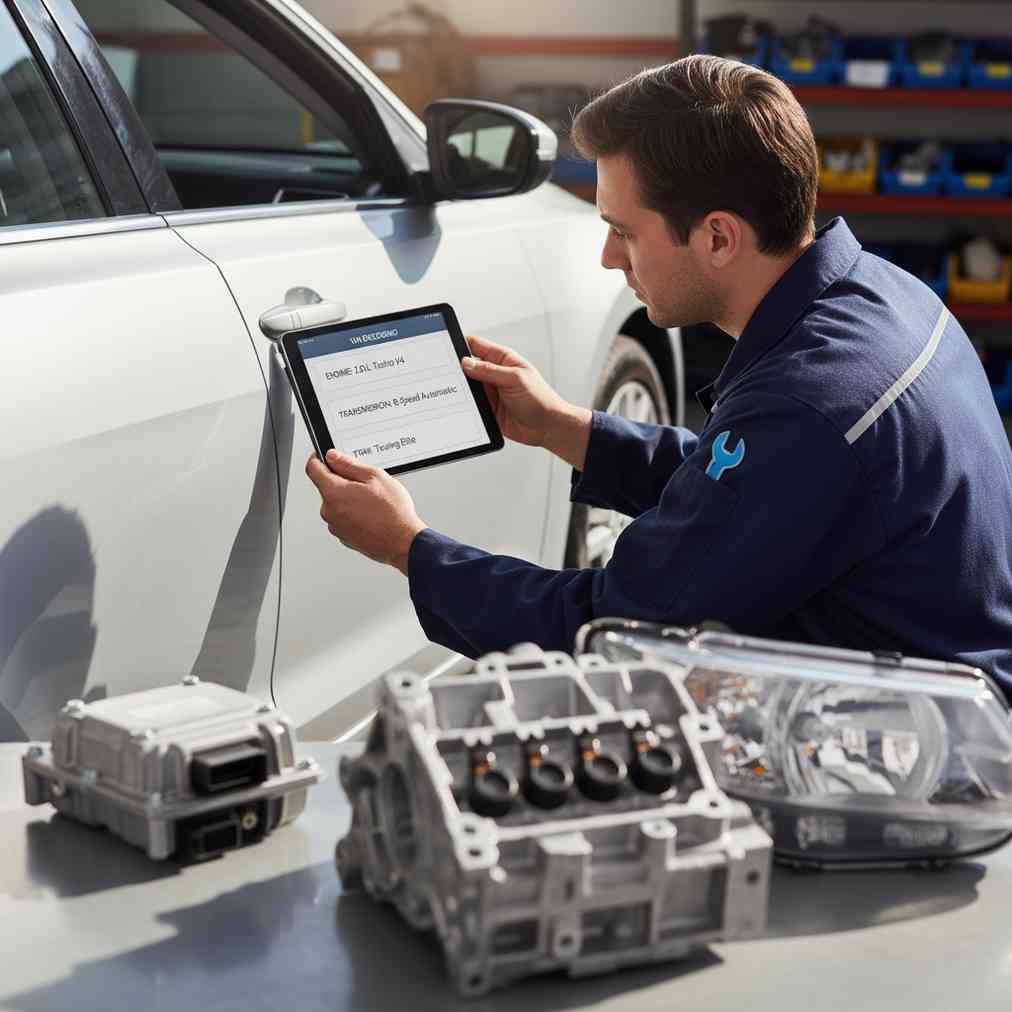Understanding the VIN Structure for Parts Compatibility
When searching for compatible donor cars for parts, understanding how to read a Vehicle Identification Number (VIN) is absolutely crucial. The VIN is a unique 17-character code that contains vital information about a vehicle’s manufacturer, model year, engine type, transmission, and trim level. This information becomes invaluable when you need to find the right parts from salvage yards near me or auto wrecking yards.
Each VIN follows a standardized format established by the National Highway Traffic Safety Administration (NHTSA) since 1981. This standardization means that every passenger car and light truck manufactured has a consistent 17-character structure that can be decoded to reveal specific vehicle details essential for parts matching.
Breaking Down the 17-Character VIN Code
| VIN Position | Information Revealed | Parts Compatibility Relevance |
|---|---|---|
| 1-3 (WMI) | World Manufacturer Identifier | Identifies manufacturer and country of origin |
| 4-8 (VDS) | Vehicle Descriptor Section | Engine type, transmission, body style, restraint systems |
| 9 | Check Digit | Validates VIN authenticity |
| 10 | Model Year | Critical for parts compatibility timing |
| 11 | Assembly Plant | Manufacturing location identifier |
| 12-17 (VIS) | Vehicle Identifier Section | Unique production sequence number |
The most critical positions for parts compatibility are positions 4-8 and position 10. These sections reveal the engine specifications, transmission type, and model year – all essential factors when determining if parts from a donor vehicle will fit your car.
Essential VIN Decoding Tools for Parts Matching
Using reliable VIN decoder tools is fundamental to extracting accurate vehicle specifications. According to industry professionals, “The VIN is the fingerprint of a vehicle. Learning to read its basic structure, and then utilizing reliable decoding tools, is fundamental for anyone involved in auto repair, restoration, or salvaging.”
Recommended Free VIN Decoder Tools
- NHTSA VIN Decoder – Federal government database providing authoritative VIN decoding with recall information
- VINCheck (NICB) – National Insurance Crime Bureau tool for identifying stolen vehicles and basic specifications
- Edmunds VIN Decoder – Comprehensive lookup detailing vehicle features, specifications, and original pricing
- DecodeThis – Focuses specifically on engine, transmission, and trim details
These tools help you extract detailed vehicle specs that directly inform parts selection and donor vehicle compatibility. The accuracy of these decoders significantly reduces return rates for incorrect parts orders, with industry data suggesting returns drop by over 20% when VIN lookup is used consistently.
Step-by-Step VIN Verification Process
When looking for donor cars at junkyards for OEM parts, follow this systematic approach to ensure compatibility:
Phase 1: VIN Location and Recording
- Dashboard location – Near the windshield on the driver’s side
- Driver’s door jamb – Inside the door frame
- Vehicle paperwork – Registration, insurance documents, or title
- Engine bay – Often stamped on the engine block or firewall
Phase 2: Decoding and Analysis
- Input the complete 17-digit VIN into a reliable decoder tool
- Extract key specifications including engine code, transmission type, and trim level
- Note any specific option packages or manufacturing variations
- Cross-reference with your vehicle’s VIN for compatibility confirmation
Phase 3: OEM Part Number Verification
The decoded VIN information guides you to exact OEM (Original Equipment Manufacturer) part numbers. Many original parts have stamped or printed OEM numbers (e.g., “VW 06B 903 023”) that help cross-verify compatibility between your vehicle and the donor car.
Critical Parts Matching Checklist
Before purchasing parts or selecting donor vehicles, use this comprehensive verification checklist:
| Verification Step | Key Details to Confirm | Why It Matters |
|---|---|---|
| Engine Specifications | Engine size, type (V6, 4-cylinder, diesel), specific codes | Ensures proper fitment for engine components |
| Transmission Type | Automatic vs manual, gear count, specific model | Critical for drivetrain component compatibility |
| Trim Level Matching | LX, EX, Sport variants and option packages | Affects suspension, interior, and body components |
| Model Year Verification | Exact production year from position 10 | Prevents incompatibilities from mid-year changes |
| Safety Component Check | Airbag systems, seatbelts, crash sensors | Ensures no recall-related safety issues |
Pro Tip: Always cross-reference VIN-decoded information with OEM part catalogs or inspect existing parts for stamped OEM numbers. This dual verification approach significantly reduces compatibility errors.
Common VIN Decoding Mistakes to Avoid
When searching for compatible parts, VIN matching becomes especially important to avoid costly errors. Here are the most frequent mistakes:
- Ignoring mid-year production changes – Manufacturers sometimes modify specifications during a model year
- Assuming trim level compatibility – Different trim levels may have incompatible suspension, brake, or electrical components
- Overlooking recall information – Some parts may have safety recalls that make them unsuitable for reuse
- Relying solely on model year – Engine and transmission options can vary significantly within the same model year
- Skipping OEM number verification – VIN decoding should always be confirmed with actual OEM part numbers
Advanced VIN Analysis for Complex Parts
Modern vehicles increasingly feature complex electronic systems and customization options. For components like turbochargers, transmissions, or electronic control modules, deeper analysis may be required:
Electronic Systems Compatibility
- ECU programming – Electronic control units may require specific software versions
- Wiring harness variations – Different trim levels may have incompatible electrical connections
- Sensor compatibility – Advanced safety systems require precise sensor matching
- Communication protocols – Modern vehicles use specific data bus systems that must match
Hybrid and Electric Vehicle Considerations
The rise of electric vehicle parts from junkyards introduces new complexity layers. VIN decoders must accurately interpret advanced powertrains, battery systems, and high-voltage components that require specialized handling and compatibility verification.
Maximizing Your Parts Search Success
To increase your success rate when looking for compatible donor cars, consider these strategic approaches:
Multiple Verification Sources
- Use multiple VIN decoder tools to cross-verify information
- Consult manufacturer-specific parts diagrams when available
- Check with dealership parts departments for complex components
- Utilize aftermarket parts databases for additional confirmation
Documentation and Record Keeping
- Photograph both your vehicle’s VIN and the donor vehicle’s VIN
- Save decoder results for future reference
- Record OEM part numbers from removed components
- Maintain a compatibility database for your specific vehicle model
Industry Trends and Future Developments
The automotive salvage industry continues evolving with enhanced digital VIN decoding databases. These improvements have increased precision in matching transmission and engine types, reducing errors especially in vehicles with multiple trim variations across the same model year.
Enhanced VIN decoding capabilities now include more detailed option code interpretation and better integration with manufacturer electronic parts catalogs (EPCs). Many salvage yards now use VIN matching software to quickly identify and remove recalled or incompatible parts from inventory, streamlining safe parts resale.
Getting Professional Help
When dealing with complex or high-value components, don’t hesitate to seek professional assistance. Many experienced salvage yard operators can help decode VINs and verify compatibility. If you’re considering selling your junk car for cash to fund your parts purchase, professional evaluation can ensure you get the best value.
Remember that VIN decoding is just the first step in successful parts sourcing. Combined with careful physical inspection, OEM number verification, and professional guidance when needed, VIN analysis becomes a powerful tool for finding exactly the right parts for your vehicle repair or restoration project.
Conclusion
Mastering VIN decoding for parts compatibility opens up significant opportunities for cost savings and successful vehicle repairs. By understanding the 17-character structure, utilizing reliable decoder tools, and following systematic verification processes, you can confidently identify compatible donor vehicles and source the exact parts you need.
The key to success lies in thorough verification – never rely on a single source of information. Cross-reference VIN data with OEM numbers, use multiple decoder tools, and don’t hesitate to seek professional verification for critical components. With these skills and knowledge, you’ll transform from a casual parts searcher into an informed buyer who consistently finds high-quality, compatible parts at fraction of new parts costs.





Leave a Reply
You must be logged in to post a comment.